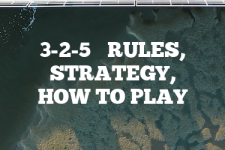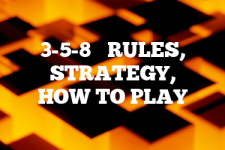Elfern: A Deep Dive into the Classic Card Game – Rules, Winning Strategies, and How to Play Guide
Introduction
Elfern is a classic German card game that has been around since the 19th century. We’ve explored some other German card games on BC before, and Elfern is quite similar enough that, if you’re like me, you probably ‘get’ how to play it fairly quickly. It’s a trick-taking game that requires strategy, skill, and a bit of luck. It’s played with a standard deck of 32 cards, and can be enjoyed by 2 to 6 players.

Elfern, alternatively known as Figurenspiel, Elfmandeln, or Bohemian Schneider, is a two-player trick-and-draw game from Germany and Austria. The game uses a 32-card piquet pack and involves no trumps. It involves six cards and the goal is to secure the majority of the 20 ‘honours’, which include the ace, king, queen, jack, and ten.
Quick Tip for Elfern
Remember, in Elfern, the goal is not to win every trick, but to win the right tricks. Keep an eye on the cards your opponents are playing and adjust your strategy accordingly.
Rules for playing Elfern
The rules of Elfern are relatively straightforward. The game is played in rounds, with each player taking turns to lead a trick. The player who leads a trick can play any card from their hand, and the other players must follow suit if they can. If they can’t follow suit, they can play any card. The player who plays the highest card of the leading suit wins the trick and leads the next one. The game continues until all cards have been played.
While these are the official rules, many players enjoy adding their own ‘house rules’ to add variety and challenge to the game. For example, some players might decide that the player who wins a trick must lead the next one with a card of the same suit.
The Deal for Elfern
In Elfern, each player is dealt a hand of 6 cards in sets of 2, with no designated trumps, and tens holding a low rank in trick-play.
How to Play Elfern
Setup
At the start of the game, the dealer shuffles the deck and deals out the cards. The player with the ‘elder’ hand leads the first trick, which is won by the player with the highest card of the led suit.
Gameplay
Players take turns leading tricks and trying to win them by playing the highest card of the leading suit. In the initial phase of the game, the trick winner draws a card from the stock, followed by the other player, before leading to the next trick. During this phase, players are not required to follow suit.
End of the Game and Scoring
The game ends when all cards have been played. The player who has won the most tricks is the winner. If there’s a tie, the player who won the last trick is the winner.
How to Win at Elfern
Winning at Elfern requires a combination of strategy, skill, and a bit of luck. Here are some strategies that can help you improve your game:
- Pay attention to the cards your opponents are playing. This can give you clues about what cards they might have left in their hand.
- Try to control the game by winning tricks with high cards early on. This can give you the advantage of leading tricks and controlling the flow of the game.
- Don’t be afraid to lose a trick if it means you can win a more important one later on. Remember, the goal is not to win every trick, but to win the right tricks.
Best Strategies for playing Elfern game
While there’s no surefire way to win at Elfern, there are some strategies that can increase your chances of winning:
- Try to keep a balanced hand. Having a variety of suits in your hand gives you more options and makes it harder for your opponents to predict your moves.
- Be mindful of the order in which you play your cards. Sometimes, it’s better to hold back a high card and play it later in the game when it can win you a crucial trick.
- Keep track of the cards that have been played. This can help you figure out what cards your opponents might have left in their hand.
Game Variations of Elfern
There are several variations of Elfern that can add variety and challenge to the game. For example, in some variations, the player who wins a trick must lead the next one with a card of the same suit. In other variations, the game is played with a double deck for a longer and more challenging game.
Scenarios for Elfern
There are many different scenarios that can arise in a game of Elfern, and knowing how to navigate them can be the key to winning the game. Here are some common scenarios and strategies for dealing with them:
- If you have a lot of high cards in your hand, try to win tricks early on to gain control of the game.
- If you have a lot of low cards in your hand, try to lose tricks early on to get rid of your low cards and save your high cards for later.
- If you’re not sure what card to play, consider playing a card of a suit that you have a lot of. This can increase your chances of winning the trick and give you control of the game.
Frequently Asked Questions about playing Elfern game
Here are some common questions and answers about playing Elfern:
- What happens if there’s a tie at the end of the game? If there’s a tie, the player who won the last trick is the winner.
- Can I play a card of a different suit if I can’t follow suit? Yes, if you can’t follow suit, you can play any card.
- What happens if I run out of cards of a certain suit? If you run out of cards of a certain suit, you can play any card.
- Can I play a high card to win a trick even if I could follow suit with a lower card? Yes, you can play any card of the leading suit, regardless of its rank.
- Can I play Elfern with more than four players? Yes, Elfern can be played with 2 to 6 players.
External Links
While the game’s earliest documentation dates back to the 19th century, game historian David Parlett proposes that its lack of designated trumps indicates a potentially greater antiquity, potentially linking it to Ace-Ten card games, or more precisely, King-Queen card games.

Eve Brownlee was a gamer before gaming communities on the internet were a thing. Eve grew up playing traditional, standard deck card games like Rummy and Bezique, taking an interest in the classics Backgammon and Chess. Parlor card games like Bridge continue to keep Eve active in the community. After a long career, primarily in horticulture for USDA in Maryland, Eve now travels and writes on The Pineapple (pineapples.info) and contributes to Quora/Pinterest topics. Contact Eve via email.



